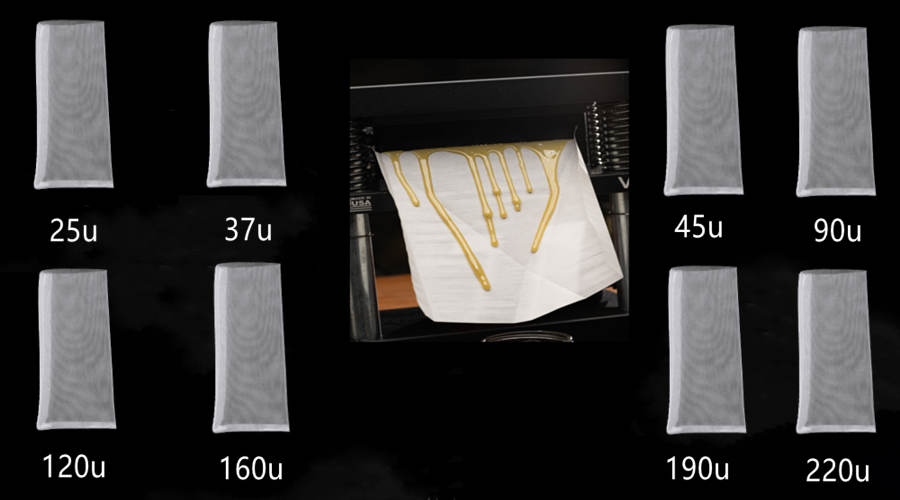
The most popular microns for rosin extractors are 15, 25, 37, 50, 75, 90, 120, 160, and 220.
A 15 micron rosin filter bag has smaller pores in the material, allowing for finer filtration. 220 micron filter bags have large holes in the material, making them thicker filters that allow larger materials to pass through.
The source material you use determines the optimal micrometer selection. For example, flattening big Fried Dough Twists requires a larger micron size, because there will be a higher proportion of unwanted lipids, micro plant particles and other compounds. In order to accommodate these additional materials present in the rosin, a larger gap is required in the filter so that everything can be smoothly and completely pressed out. One of the key things to remember when pressing rosin is stable and unobstructed flow.
Diferent micron rosin press bags function
15 microns
The smaller the micrometer size, the finer the mesh. A 15 micron rosin sachet is the best choice. In many cases, it is best not to use them as they will prevent you from achieving optimal yield. However, they can be useful for ultrafine materials.
If you want to extract rosin from fragile dry sieves or bubble hashes, you may need to try a 15 micron bag. These bags can prevent material from overflowing from the bag when you press, and you can extract rosin without any worries.
25 microns
The next step for a 15 micron rosin sachet is a 25 micron rosin sachet. These bags are very sturdy and provide very small pores for rosin penetration. Therefore, their use is not much different from that of 15 micron bags, although you may prefer larger micron sizes.
If you extract rosin from fine dry sieves or bubble hashes, these bags are worth using, and you usually get better yields than using 15 micron bags. You may want to test both to see which one is more suitable for your product.
37 microns
A 37 micron pine fragrance bag is one of the best choices. The size of these bags is just suitable for many purposes. You can use 37 micron bags to extract rosin from dry sieve, hash or big Fried Dough Twists, but whether you should use them depends on the amount and output you are looking for.
These bags will provide you with excellent yields for extracting rosin from hashes and kiffs. They can also provide you with high-quality large Fried Dough Twists or pruning output, although you may want to use a larger micron size to achieve higher output.
90 microns
Compared to 37 micron bags, 90 micron bags have a significant increase and should not be used for dry sieving or hashing. These bags have large holes, which are most suitable for extracting rosin from hemp or big Fried Dough Twists and accessories.
Using a 90 micron bag to hold flowers or decorations will yield higher yields than using a 37 micron bag. Not only will you receive more rosin, but the quality of the rosin you extract is still very good. If you want to extract rosin from flowers, a 90 micron bag is the ideal choice.
120 microns
If you want a larger mesh size, you can use a 120 micron rosin sachet. Although these methods may not be useful if you extract rosin from hashes or kiffs, they may be useful if you use flowers and want to achieve excellent yields.
The difference between 90 micron bags and 120 micron bags is that 120 micron bags will provide you with higher production, although the quality may not be as good as 90 micron bags. They are also more suitable for fresh and sticky buds, while smaller micrometers should be used for dry buds.
160 microns
Maximum flower yield, will also allow some pellets to pass through, great if you have slightly damp material that won't crumble and want a quick full spectrum extraction.
Contact: Jingda Filter Bags
Phone: +86 15100134172
E-mail: alice@jingdameshfilterbag.com
Add: No.20 Heping Road, Chang'an District, Shijiazhuang City, Hebei Province, China.